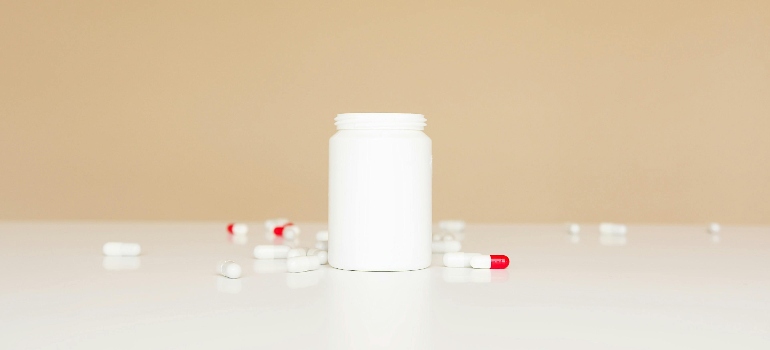Tramadol Side Effects: A Comprehensive Overview
When it comes to managing pain, Tramadol is a commonly prescribed medication that many rely on for relief. However, like any drug, it’s important to be aware of the potential side effects that can come with its use. This article provides a comprehensive overview of the Tramadol side effects associated. We aim to help you understand what to watch out for and how to stay safe while using this medication. Whether you are taking Tramadol for acute pain following surgery or managing a chronic condition like fibromyalgia, being informed about the possible side effects is key. Read on to learn more about how Tramadol might affect your body and what precautions you should take.
Jump to Section
What is Tramadol?
Tramadol, often referred to as TR, is a synthetic analgesic with opioid agonist properties. It affects the noradrenergic and serotonergic systems, working similarly to morphine. Tramadol is usually administered as tablets, capsules, or extended-release tablets. The drug binds to opioid receptors in the brain and spinal cord, changing how your body perceives and responds to pain signals. Additionally, Tramadol inhibits the reuptake of neurotransmitters like serotonin and norepinephrine, which can enhance its pain-relieving effects.

Common Mild Side Effects of Tramadol and How to Manage them
Some side effects of Tramadol are mild and manageable. Although they can be uncomfortable, they are usually not severe. However, they still require close medical attention to prevent issues like dehydration and poor nutrition. Here are some common side effects and strategies to manage them:
- Nausea, Vomiting, and Dehydration: Ensure proper hydration with small amounts of water and sports drinks frequently. For extreme vomiting, IV fluids may be necessary. Maintain dental hygiene to avoid long-lasting damage.
- Light-Headedness, Dizziness, and Drowsiness: Rest is recommended to counteract these symptoms. Patients should lie down and avoid strenuous activities. Exercise should be limited to short walks if desired. Monitor any additional medication taken, as interactions can be fatal.
- Dry Mouth: Chewing sugar-free gum, sucking on sugar-free candies, and staying hydrated can help manage dry mouth. Regular dental check-ups are important.
- Headaches: Over-the-counter pain relievers can be used, but only under a healthcare professional’s supervision. Ensuring adequate hydration and rest can also help alleviate headaches.
- Constipation: Increasing fiber intake, drinking plenty of water, and engaging in light physical activity can help. A mild laxative may be recommended by a healthcare provider.
- Excessive Sweating: Wearing light, breathable clothing and staying in a cool environment can help. Staying hydrated is also important.
Itching or Rash: Applying over-the-counter anti-itch creams and keeping the skin moisturized can help relieve itching. If the rash persists, consult a healthcare provider.
For severe or persistent side effects inpatient drug rehab centers in Pennsylvania offer comprehensive care and support. Rehab centers provide medical supervision and specialized treatment plans to help manage side effects effectively and ensure safe use of Tramadol.

Serious Tramadol Side Effects and Risks
In addition to the mild side effects, Tramadol can also cause serious and potentially life-threatening reactions. It’s important to be aware of these risks and recognize the symptoms early.
Renal Failure and Rhabdomyolysis
Although it is relatively uncommon, there have been documented cases where Tramadol has caused renal failure and rhabdomyolysis. Renal failure involves the kidneys’ inability to function properly, while rhabdomyolysis is the release of muscle cell contents into the bloodstream due to severe muscle trauma. This condition can be triggered by drugs like cocaine, heroin, ethanol, amphetamines, and caffeine. Clinically, rhabdomyolysis can present in various ways, including acute muscle pain (myalgia) and dark-colored urine (pigmenturia).
Serotonin Syndrome
Serotonin Syndrome, or SS, can also result from Tramadol misuse. This syndrome manifests as hallucinations, tachycardia, hyperthermia, hyperreflexia, and even a coma. This is all due to TR’s effect on serotonin reuptake inhibition. This can happen if you take Tramadol alongside SSRIs (selective serotonin reuptake inhibitors), selective NE reuptake inhibitors (SNRIs), triptans, MAO inhibitors, or tricyclic antidepressants.
Respiratory Depression
Respiratory depression is a hallmark side effect of all opioids, including Tramadol. It can happen suddenly or present beforehand as decreasing breathing rates. This side effect can be lethal as it can result in a respiratory-induced cardiac arrest. It can also lead to renal failure. When compared to other opioids, respiratory depression caused by Tramadol is rare, but it happens especially when there is a recreational use or addiction.

Seizures and Shoulder Dislocation Resulting from Seizures
Seizures are another potentially lethal side effect of Tramadol. These sudden, uncontrolled electrical disturbances in the brain can cause changes in behavior, movements, feelings, or levels of consciousness. Seizures can lead to loss of consciousness, accidents, secondary injuries, and other severe consequences.
A study published in the NCBI found that 50% of Tramadol overdose cases resulted in seizures. Additionally, shoulder dislocations were notably higher in patients who experienced seizures due to Tramadol misuse (P = 0.02).
Several Cardiovascular Events
The ingestion of 5 mg of Tramadol has been associated with the side effect of cardiopulmonary arrest. However, the most common effect is mild tachycardia. However, when it comes to the cardiovascular system, doctors should always monitor it closely because it can easily lead to severe heart complications, including heart arrest.
Neonatal Opioid Withdrawal Syndrome
Neonatal Opioid Withdrawal Syndrome (NOWS) occurs in newborns exposed to opioids, such as tramadol, during pregnancy. After birth, these infants may experience withdrawal symptoms like tremors, irritability, poor feeding, vomiting, diarrhea, and seizures, typically appearing within 72 hours.
Managing NOWS involves supportive care—swaddling, reducing stimuli, and frequent feedings. Severe cases may require medication. Prevention focuses on managing opioid use during pregnancy through alternatives, addiction treatment, and prenatal care. Early intervention is crucial to mitigate the effects of NOWS on newborns.
Death (Especially when Combined with Other Substances)
One of the most dangerous aspects of Tramadol is that even small substances can cause death when combined with ordinary substances like alcohol and various prescription drugs, including antidepressants. This is due to the additive effects that these substances can have on the central nervous system, leading to severe respiratory depression, profound sedation, and even coma. The risk is particularly high for individuals who misuse Tramadol or do not adhere to prescribed dosages. It is important to inform your healthcare provider about all medications and substances you are taking to avoid these potentially deadly interactions.

Long-Term Health Implications
Even though you may be spared from death, overdose, or a coma, long-term Tramadol misuse can lead to various long-term health issues.
Physical Dependence, Tolerance, and Addiction
If you develop physical dependence and tolerance to Tramadol, you will most likely need medical assistance from a detox center in Pennsylvania when quitting the substance. This is because the withdrawal symptoms can be disruptive and life-threatening. Dependence, tolerance, and addiction can also lead to overdose as your body craves increasing amounts of Tramadol to achieve the same effect. Addiction is a chronic, treatable condition that requires lifelong management and can significantly disrupt your life.
Liver and Kidney Damage
Because Tramadol is metabolized in the liver and kidneys, you place a toll on these organs. This can lead to failure or damage, especially over time. This can make other health problems more challenging and impact you for life, sometimes requiring you to get an organ transplant to regain your quality of life.
Cognitive Effects
Long-term misuse of Tramadol can lead to significant cognitive impairment. This includes trouble concentrating, memory problems, and difficulties with decision-making. Such cognitive deficits can result in poor professional and academic performance, severely impacting your quality of life. Additionally, cognitive impairment can worsen existing mental health conditions, leading to increased anxiety, depression, and other psychological issues. The combined effects can create a challenging cycle, making recovery and everyday functioning even more difficult.

Managing Pain and Addiction Recovery: Special Considerations
Recovering from Tramadol misuse is similar to recovering from the misuse of other opioids and benzodiazepines. The main challenge faced by many prescription drug addiction rehabs is managing the pain that led to the Tramadol prescription in the first place. Pain severe enough to warrant a Tramadol prescription is often difficult to manage and can be chronic, lasting for months or longer.
Some individuals manage their pain through alternative means such as acupuncture, massages, physical therapy, or non-opioid medications. However, recovering from a substance use disorder while also undergoing pain management can present unique challenges. Balancing effective pain relief with the risk of relapse requires a comprehensive, individualized approach and close monitoring by healthcare professionals.
What Comes Next?
You may opt for an intensive inpatient or outpatient detox rehab in PA. Partial hospitalization is also available. You and your medical team will discuss what fits your circumstances best.
Being ready for recovery after Tramadol misuse may also mean MAT at a detox center in Pennsylvania, though not always. During medication-assistance therapy for Tramadol, medications such as buprenorphine or naltrexone may help reduce cravings and withdrawal symptoms, particularly for individuals with severe dependence or co-occurring mental health conditions. Therapy does not start until detox is over because detox is very taxing on the body and requires the focus of the patient to be there exclusively.
After Detox: Next Steps
During recovery the patient also receives behavioral therapy such as CBT or DBT. CBT helps you identify your triggers and the root cause behind your addiction. Then, it helps you come up with strategies to avoid your triggers, cope with them if you have no choice but to get exposed to them and change your negative patterns.
DBT works better for people with other mental illnesses, or that may already be aware of their triggers and patterns but still have a hard time emotionally regulating and inhibiting their impulses. DBT often involves both individual therapy and group therapy sessions that resemble classes. In these group DBT sessions, people who struggle with similar issues are taught strategies to deal with their impulses and emotions.
At our rehab center in Lake Ariel, PA, patients also receive holistic treatment. The goal behind holistic therapeutic options is to provide you with healthy coping strategies and hobbies to deal with the stressors of everyday life once you live outside the facilities or have completed the partial hospitalization program.
We support the transition into everyday life through our programs, and for those who prefer additional support, we offer sober houses in PA. In these houses, residents no longer receive constant medical attention but remain close to therapy sessions, AA or NA meetings, and live with others dedicated to maintaining sobriety.

The Importance of Awareness with Tramadol
Understanding the side effects of tramadol is crucial for anyone considering or currently using this medication. While tramadol can be effective for managing moderate to severe pain, it comes with a range of potential side effects. Being aware of these side effects allows patients and healthcare providers to make informed decisions about its use, weighing the benefits against the potential risks.
Tramadol side effects can significantly impact an individual’s health and quality of life. By recognizing the signs of misuse and understanding the risks involved, patients can take proactive steps to manage their pain safely. If any adverse effects or symptoms of misuse are observed, it is vital to seek medical advice promptly. This comprehensive overview highlights the necessity for careful consideration and monitoring when using tramadol, ensuring that its benefits in pain management are maximized while minimizing potential harm. Always consult with a healthcare provider to discuss any concerns and to ensure safe and effective use of tramadol.